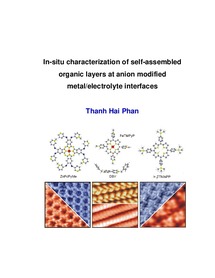Phan, Thanh Hai: In-situ characterization of self-assembled organic layers at anion modified metal/electrolyte interfaces. - Bonn, 2013. - Dissertation, Rheinische Friedrich-Wilhelms-Universität Bonn.
Online-Ausgabe in bonndoc: https://nbn-resolving.org/urn:nbn:de:hbz:5n-33116
Online-Ausgabe in bonndoc: https://nbn-resolving.org/urn:nbn:de:hbz:5n-33116
@phdthesis{handle:20.500.11811/5739,
urn: https://nbn-resolving.org/urn:nbn:de:hbz:5n-33116,
author = {{Thanh Hai Phan}},
title = {In-situ characterization of self-assembled organic layers at anion modified metal/electrolyte interfaces},
school = {Rheinische Friedrich-Wilhelms-Universität Bonn},
year = 2013,
month = aug,
note = {The self-assembly of molecular layers has become an important strategy in modern design of functional materials. The sheer unlimited “design” of the properties of the organic molecules and their well controlled deposition on suitable substrates can lead to functional surfaces with broad applications as catalysts in the field of “green energy”, as devices in state-of-the-art electronics, as sensors and collectors or emitters of light etc. to name only a few. This has motivated surface scientists to apply their broad arsenal of high resolution techniques to investigate the growth mechanisms and collective properties of organic films in order to lay the basis for a rational design of their functionality. However, in particular, large organic molecules may no longer be sufficiently volatile to be deposited by vapor deposition. In this case, deposition from solution may be a promising route; in ionic form, these molecules may even be soluble in water.
In this dissertation, results on the adsorption and self-assembly of phthalocyanine-, porphyrin- and viologen molecules as well as the competitive co-adsorption of the latter in cationic form from aqueous acidic solutions are presented and discussed. The resultant structures on anion-modified Cu(100) and Cu(111) single crystal electrode surfaces as well as structural transitions as a function of the electrochemical potential have been studied in situ, i.e. in solution, by cyclic voltametry (CV) and scanning tunneling microscopy (STM) as well as by ex situ X-ray photoelectron spectroscopy (XPS). In all cases the molecular cations spontaneously form well ordered monolayers whose structure depends on the symmetry of the metal substrate, i.e. Cu(100) and Cu(111), the preadsorbed anion layers, i.e. chloride, bromide, iodide and sulfate, as well as on the applied electrode potential. The resultant structures, imaged with submolecular resolution by in situ STM, are clearly correlated with the redox state of the molecules as indicated by CV and verified by XPS. As a result, detailed structure models are derived and are discussed in terms of the prevailing interactions.},
url = {https://hdl.handle.net/20.500.11811/5739}
}
urn: https://nbn-resolving.org/urn:nbn:de:hbz:5n-33116,
author = {{Thanh Hai Phan}},
title = {In-situ characterization of self-assembled organic layers at anion modified metal/electrolyte interfaces},
school = {Rheinische Friedrich-Wilhelms-Universität Bonn},
year = 2013,
month = aug,
note = {The self-assembly of molecular layers has become an important strategy in modern design of functional materials. The sheer unlimited “design” of the properties of the organic molecules and their well controlled deposition on suitable substrates can lead to functional surfaces with broad applications as catalysts in the field of “green energy”, as devices in state-of-the-art electronics, as sensors and collectors or emitters of light etc. to name only a few. This has motivated surface scientists to apply their broad arsenal of high resolution techniques to investigate the growth mechanisms and collective properties of organic films in order to lay the basis for a rational design of their functionality. However, in particular, large organic molecules may no longer be sufficiently volatile to be deposited by vapor deposition. In this case, deposition from solution may be a promising route; in ionic form, these molecules may even be soluble in water.
In this dissertation, results on the adsorption and self-assembly of phthalocyanine-, porphyrin- and viologen molecules as well as the competitive co-adsorption of the latter in cationic form from aqueous acidic solutions are presented and discussed. The resultant structures on anion-modified Cu(100) and Cu(111) single crystal electrode surfaces as well as structural transitions as a function of the electrochemical potential have been studied in situ, i.e. in solution, by cyclic voltametry (CV) and scanning tunneling microscopy (STM) as well as by ex situ X-ray photoelectron spectroscopy (XPS). In all cases the molecular cations spontaneously form well ordered monolayers whose structure depends on the symmetry of the metal substrate, i.e. Cu(100) and Cu(111), the preadsorbed anion layers, i.e. chloride, bromide, iodide and sulfate, as well as on the applied electrode potential. The resultant structures, imaged with submolecular resolution by in situ STM, are clearly correlated with the redox state of the molecules as indicated by CV and verified by XPS. As a result, detailed structure models are derived and are discussed in terms of the prevailing interactions.},
url = {https://hdl.handle.net/20.500.11811/5739}
}






